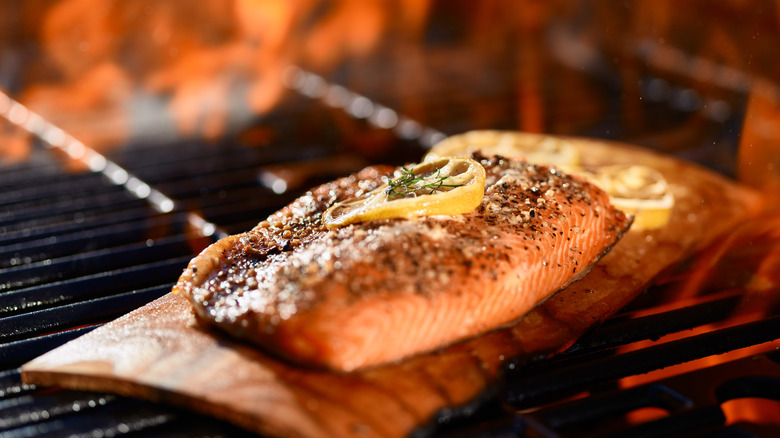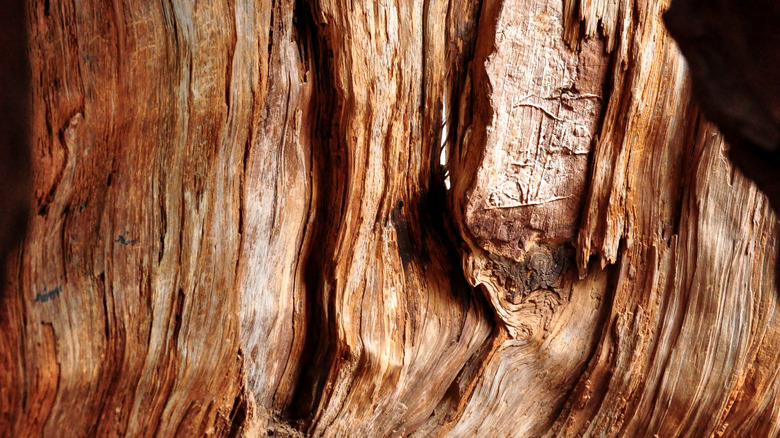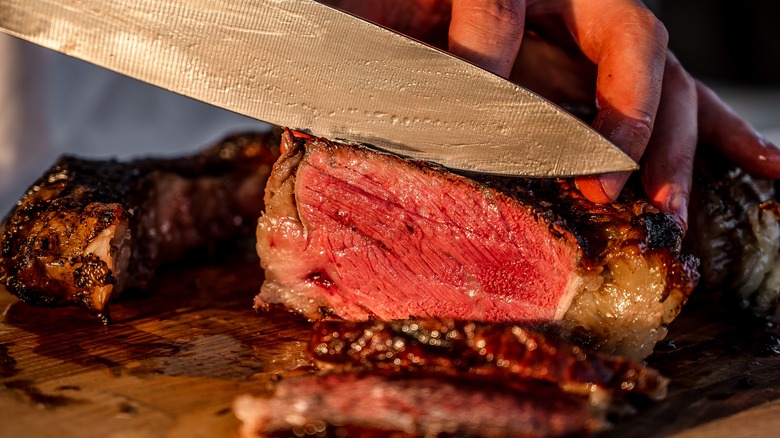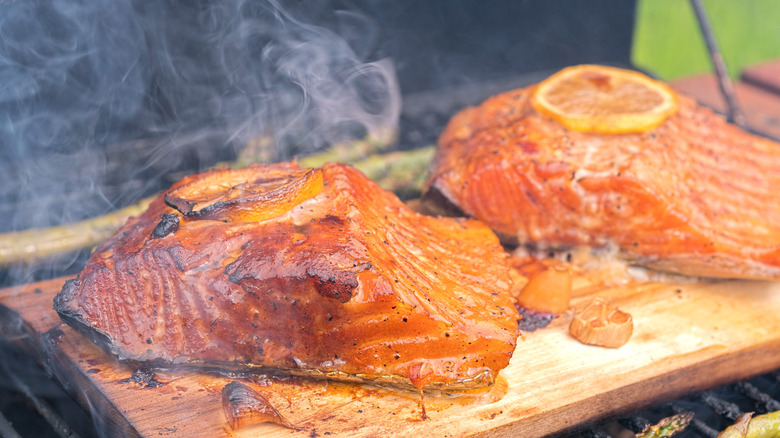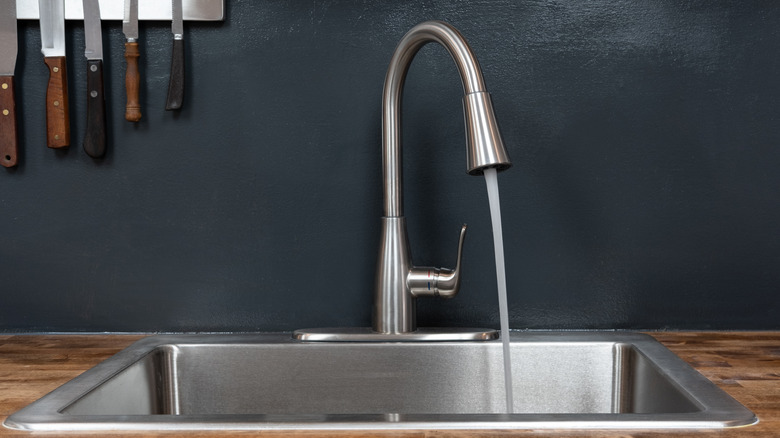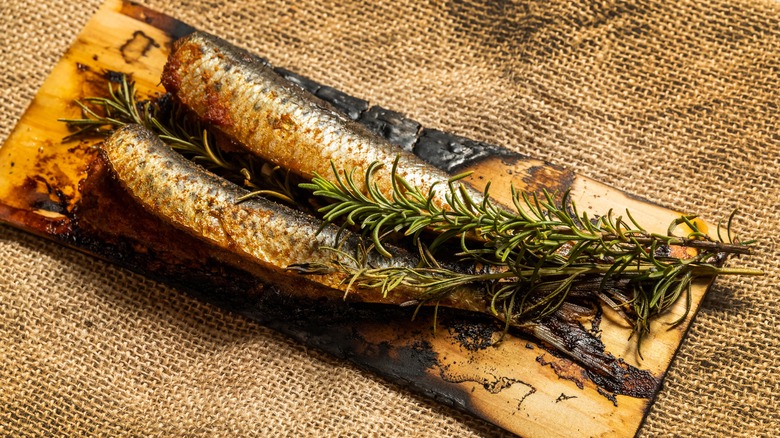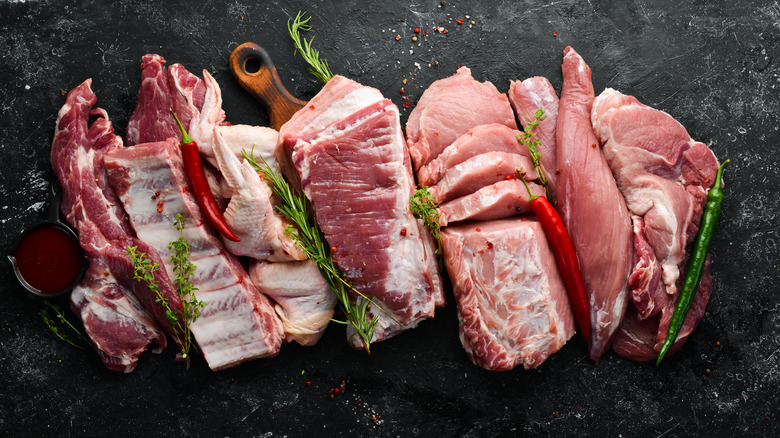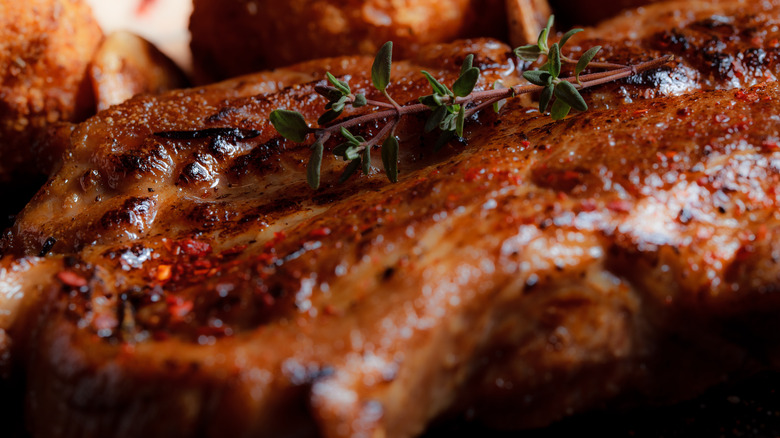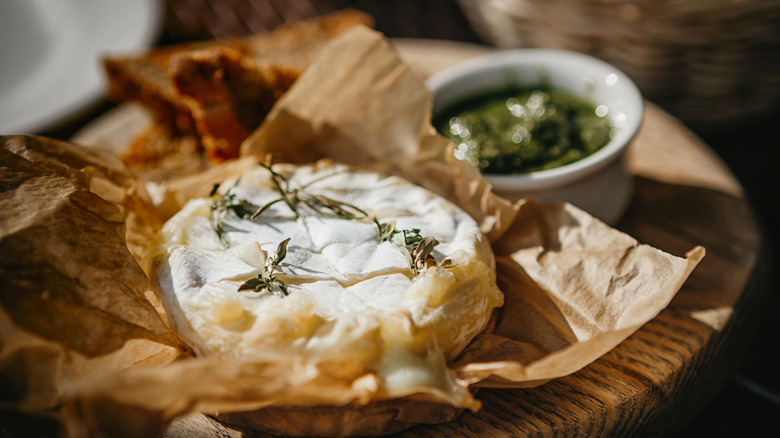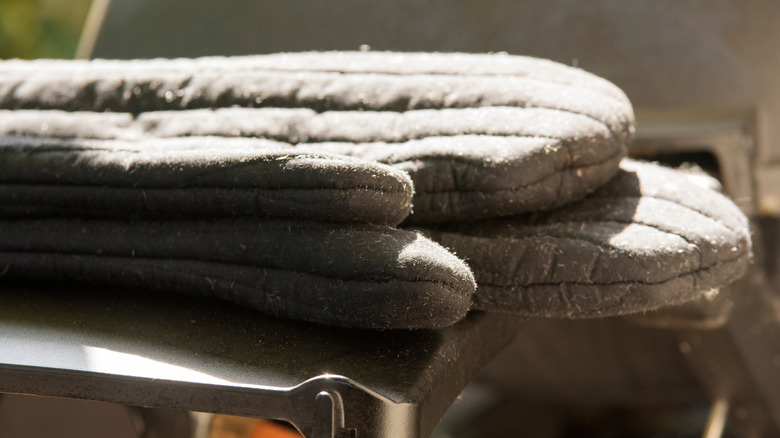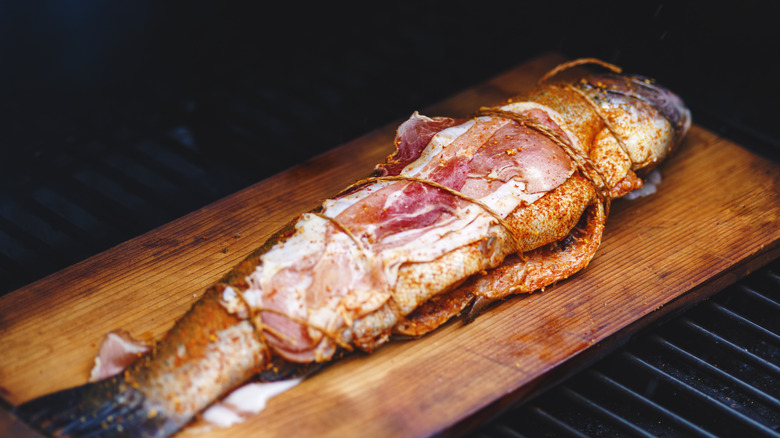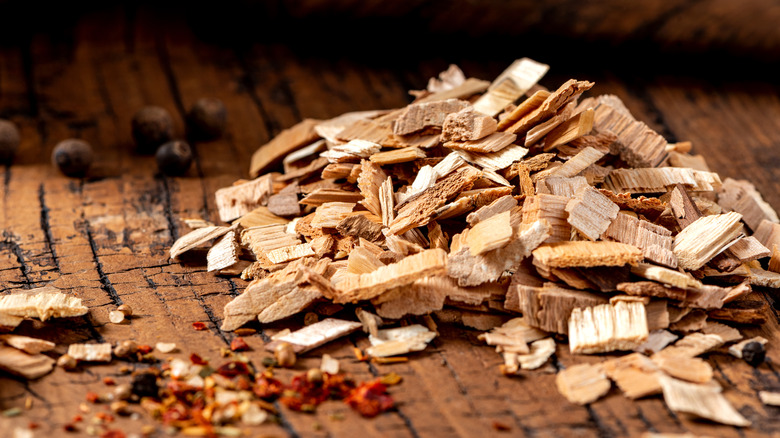Everything You Should Know About Grilling With Wood Planks
Let's face it, anyone who knows the basics of grilling enjoys cooking directly over an open flame. It gives meat that unforgettable smoky flavor and crispy texture. Though it's hard to imagine deviating from this tried-and-true method, consider enhancing the natural flavor and tenderness of your dish by using wooden planks. Using a slab of wood for grilling is an ancient tradition that not only adds a smoky infusion to your protein of choice but regulates the moisture content and rate at which the item is cooked.
According to NPR, "planking" is an indigenous technique originating from the Pacific Northwest. Cedar planks were originally used for grilling whole fish over an open flame, resulting in an evenly cooked, juicy, and tender catch. Today, we continue the tradition by using wood planks for grilling fish, meat, fruits, and vegetables. Grilling with wood planks is a technique used by top chefs, grill masters, and barbecue kings and queens all over the world, and there are a few key reasons why.
Infuse your dish with unique flavors
The first notable benefit of grilling with wood planks is the addition of a unique smokey flavor that different types of wood can provide. The natural scents and flavors of the lumber are released during the heating process, resulting in the infusion of flavor into your cut of meat or vegetable.
When it comes to choosing lumbar, oak tends to be a favorite amongst pit masters. Wade Fowler of Fowler's Southern Gourmet explained in an interview with The Fayetteville Observer why oak is a staple in his grill, "I think that oak has enough character to impart good smoke flavor on even the more flavorful and biggest pieces of meat. It is not too strong to overpower milder and smaller meats like chicken." This versatile wood carries a sweet and meaty flavor. But, there are plenty of trees in the forest to choose from that result in a variety of flavor infusions.
Enjoy perfectly cooked meat
Beyond altering the flavor of the dish, the barrier of the plank between the grill and the cut of choice ensures an evenly–cooked meal. While the plank does heat up and may even char, the wood creates an even distribution of heat and acts as a "heat shield," as described by Char-Broil, which prevents food from burning. This slow–cooking technique results in juicy and tender meat, fish, and vegetables, all infused with a subtle smokey flavor.
This technique is an especially important technique for cooking delicate fish, which can easily fall apart or toughen up when overly manipulated. Just set and cook — no flipping required. Cedar plank grilled salmon is a popular dish for this exact reason, and it's why first–time plank grillers often start with a fish filet. With the use of planks, gourmet culinary creations like grilled fish go from expert–level difficult to doable.
Choosing your wood plank
Now, it's important to note that you can't choose just any old piece of wood that you picked up at the lumberyard or hardware store. Many cuts of wood are treated with chemicals to deter rot and will alter the flavor of your meal. Even worse, your food could absorb the chemicals, resulting in toxicity. It's best to do your research and only purchase reliable food-grade wood planks made for grilling. These cuts are typically ½ inch thick, but you can choose a thicker plank if you plan on using it more than once or slow-cooking a larger piece of meat.
The flavor of the dish is dependent on the tree the wood plank is cut from. While cedar is the most commonly used for grilling with wood planks in America — and has been for centuries because of its accessibility and strong flavor — it may not be the perfect pick for every cut of meat, per Gourmet Grillmaster. While similar to cedar, alder has a milder flavor and is a wood that pairs well with seafood and white meat. In comparison, hickory is an all-time pick for meat lovers who enjoy a robust, smokey infusion. Remember, cooking technique affects flavor as well, so be sure to treat your wood plank properly before grilling.
Treat your plank before grilling
As we learned in the caveman era, wood catches fire. To ensure your plank doesn't burn to bits before your dish is done, It's important to avoid common mistakes when grilling with planks. Soak the wood plank for at least one hour before it comes in contact with heat, per Grilling Companion. Use a heavy, clean object to submerge the plank in water, salt water, or even wine or fruit juice for added flavor. Pit masters often suggest adding a tablespoon of salt and vinegar to the water bath to bring out the natural flavors of the wood.
After soaking, pat the plank dry before rubbing the top side with a light layer of cooking oil. This will be the side to place your meat, fish, fruit, or vegetables on. Most grill masters suggest pre-grilling the board for about two minutes on each side to release the wood's natural flavor before adding your food of choice. However, this isn't the only step that will affect the flavor outcome of your dish.
Always grill fish on a wood plank
Choosing a plank is like pairing food with wine. Each holds a distinct flavor, and it's important to enhance, not overpower, the natural flavor of your cut of choice. Fish is favorable when it comes to plank-grilling because of its tender and flakey texture. The wooden barrier ensures that the flesh doesn't char, and is cooked evenly without needing to flip. All-in-all, grilling fish on a wood plank is a real game-changer for the outcome of both the texture and flavor.
Salmon is the most common fish for cedar plank grilling, but any fish, crustacean, or mollusk can be cooked on a wooden plank over an open flame, per Forbes. Because of the subtle flavor of seafood, it's particularly important to purchase a high–quality plank and choose your wood carefully.
Cedar, alder, cherry, and maple are often chosen for seafood grill–outs because of their mild and sweet flavors. Barbecue icon Aaron Franklin suggests using alder or pecan for plank-grilling fish because of the mild flavor and faster burn (via MasterClass). While preparing your board, add a little salt to the water bath to enhance the natural seafood flavor of the fish. Be sure to remove your fish and plank from the grill a few minutes before you think it's done. The fish will continue to cook on the hot plank and flake apart with a fork when it is ready to serve.
When cooking red meat, pre-grill your plank
Red meat and gamey poultry can handle stronger flavors like mesquite, oak, and hickory. Because hickory burns at a slower pace, it is favorable for larger cuts of meat. Thinner cuts, such as steak or lamb chops can be cooked on a faster-burning wood because of their shorter cooking time.
Much like you would for an oven–cooked steak, the Chicago Steak Company recommends searing your red meat at a high temperature on the grill to lock in the juices. Do this to both sides before adding it to the plank for slow cooking. Don't forget to pre-grill the plank to bring out a more intense woody flavor, which pairs nicely with red meat.
Much like fish, the meat will continue to cook after the plank is removed from the grill. Be sure to remove thin cuts of meat prematurely and allow it to finish cooking on the wood plank.
Add layers of flavor to your grilled poultry
Poultry can be particularly nice when plank-grilled because the wood not only adds another dimension of flavor, but the layer of water-soaked wood prevents the meat from drying out, per Wildwood Cooking. Any cook knows there is nothing worse than dry chicken.
Cedar and applewood are top picks for plank-grilled poultry, notes Bliffert Lumber & Hardware, but mesquite and hickory have powerful distinct flavors that pair nicely with chicken. Pecan and maple have a subtle, yet sweet flavor that pairs nicely with poultry and pork, says MasterClass.
Poultry thighs and wings cook fairly quickly, so unless you plan to keep a close watch over the grill, it's recommended to cook whole or half birds. You can do this by purchasing an extra large plank, or placing two smaller planks side–by–side. Keep in mind that you'll want to opt for a new or thicker board when slow roasting to prevent the wood from burning up before the dish is done.
Consider making grilled cheese on a wood plank
While grilling cheese may sound like a messy and nearly impossible task, planking has made it possible. This technique is a bit more tedious than your standard meat dish but can result in some unforgettable flavors and textures.
The all-time favorite, cedar, is again the most commonly used board for smoking cheeses, but applewood, cherry, and maple round out the flavor and aromas nicely. While pre–grilling the board is still encouraged, it's recommended that you let the board cool before adding the cheese, which should be kept in the refrigerator up until the last minute, per Wildwood Grilling. Unlike meat that will sear, the cheese will melt quickly, so it's important that you practice an indirect grilling method. If using a charcoal grill, distribute the coals around the outer rim of the grill before placing the plank in the middle. For a gas grill, light only the side burners. This will ensure your cheesy masterpiece doesn't become a puddle.
If you choose to top your cheese with a preserve or dried berries, consider pairing the flavor of the topping with the board as well as the cheese. Use a low temperature, and keep an eye on your grill. This should take between eight to 10 minutes, and often less for softer cheeses like brie.
Planks are not just for meat
As the vegetarian diet gains popularity, it's important to note that grilling is not an exclusively carnivorous activity. And for die-hard meat-eaters, remember that nothing pairs better with a juicy steak than grilled onions, garlic, and mushrooms. If you've spent time mastering how to grill vegetables, you can relate to the frustration of losing half your bounty to the fiery pits of the grill. Furthermore, veggies char easily, especially when cooked at a similar heat as the burgers sitting next to them.
Enter planking. Not only will those vegetables finally stay on top of the cooking surface, but the wooden barrier reduces the amount of blackened and chard tips on your thinner and more leafy produce. Using the sweetest wood, cherry, for fruits and vegetables alike is recommended, while maple carries similar notes, per Bliffert Lumber & Hardware.
Don't forget about dessert! It's time to get adventurous because there are unexpected fruits that grill up nicely. Pair stone fruits with a cherry plank to protect the delicate flesh from harsh flames while absorbing the smoky sweet notes from the wood. Caramelize the natural sugars in grapes, pineapple, peaches, pears, cherries, and apples by placing them on a hot wood plank over an open flame.
Practice safe grilling
While wood plank grilling is a fairly straight–forward process, it's important to remain diligent and follow the proper procedures to prevent injury.
Although a properly treated food-grade plank should be smooth, check for splinters. Splinters can not only be dangerous when handling the wood but can get lodged into the food, as well. Simply sand out and remove any splinters found in the plank before use.
Pre-soaking the plank before grilling can prevent the wood from catching fire, but it's always smart to keep a spray bottle of water nearby. Especially for slow–roasts, the edges of the plank may dry out faster and be more susceptible to catching fire. Simply spray the plank if you see this happening, per Mountain Democrat.
Once the plank has been exposed to the flame, it will be very hot. Do not handle the plank with bare hands until it has fully cooled down. Use a flame-retardant oven mitt or tongs to manipulate the plank on the grill, and remove it after cooking. Be conscious that the underside of the board may contain embers that continue to burn after the grill has been turned off.
Re-use and store it properly
Although wood planks for grilling are reusable, there are a few key steps that need to be taken to ensure safety during secondary use. Topcellent suggests first removing all residue from the used plank with hot water and a new sponge or scraper. Do not use soap, as the wood will absorb it and produce a chemical flavor and toxic residue when reheated.
Store the plank in your freezer to prevent the growth of bacteria. Upon its reuse, be sure to heat the board thoroughly to kill off any remaining bacteria. If you used the board to cook salmon the first time around, stick to fish during the second use. Just like the dish absorbs the aroma and flavor of the wood, the wood absorbs the aroma and flavor of the dish. There's nothing worse than fishy chicken.
Once the wood plank is charred throughout and becomes unusable, you can compost it and purchase a new board, or break it up and use it to smoke meat using wood chips in your next grilling endeavor.
Recycle your plank into smoking chips
The use of smoking chips for grilling will give your dish that similar smokey yet subtle woody flavor as a plank, and it is a safe way to recycle the used wood. The main difference between the two is that when using chips, your meat, seafood, or vegetables is cooked directly on the grill.
Break up the used plank with your hands, or if it's still too stiff, you can opt for a saw. Cutting Edge Firewood finds wood chunks favorable to chips because of their slower burn, so don't be afraid to leave your plank in large pieces. If using a charcoal grill, simply place the wood chunks on top of the coals. For an electric or gas grill, you may need to use a smoke box or tin foil to help the chips produce smoke, rather than just catch fire. Place the chips in their box over direct heat until they begin to smoke, then move them to the outer side of the grill while you cook your dish, per Char-Broil.
The smoky aromas and flavors of plank and wood chip grilling are timeless and elite, so it's important not to waste your leftover planks when you can get a second use out of them.
